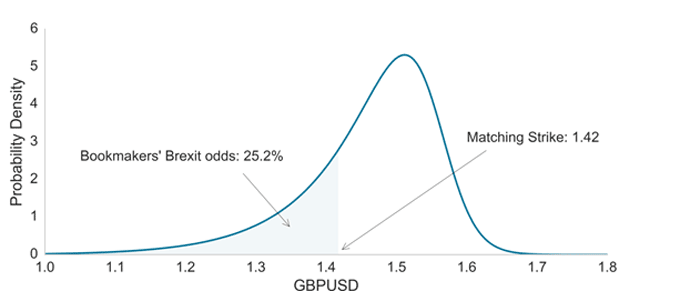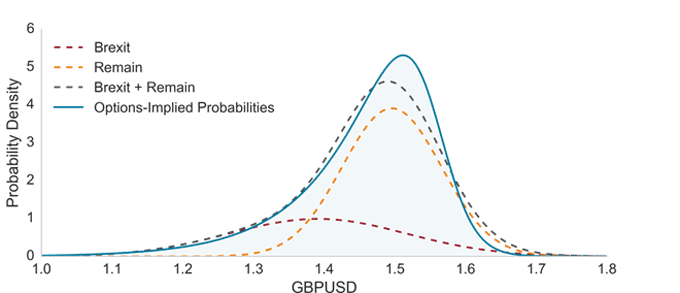Subscribe
Sign up for timely perspectives delivered to your inbox.

With the June 23rd 2016 UK referendum on EU membership rapidly approaching, in this note we examine two common vehicles for expression of “Brexit” views – thef GBP-USD currency pair and over-the-counter betting markets – and consider the implied Brexit probabilities embedded therein. Our approach is unapologetically mathematical, but for those whom this brings back terrible memories of school, the final paragraph both summarises the results and provides a suggestion for how to think about risk hedges going into the vote.
Currently, an equally-weighted average of quoted odds taken from five popular betting websites yields an implied Brexit probability of 25%. Such a bet, being binary in nature, provides a clean expression of the outcome of the referendum. Furthermore, with over £10 million wagered thus far and activity levels continuing to rise, there are good grounds for considering the associated probabilities to be plausible reflections of the collective market view.
Nevertheless, betting markets are not large enough to be able to cope with institutional flows; moreover, investor restrictions generally also prevent participation in such view-expression vehicles. Accordingly, investors who wish to hedge or assume other Brexit-related risk are required to look to more traditional assets. A popular choice in this regard has been the Sterling-Dollar exchange rate, with views tending to be implemented either outright, or using options.
However, in moving from a binary product (a bet with a bookmaker) to a product with a continuum of outcomes (GBP-USD rate), we move from a discrete space to a continuous one. Thus when considering probabilities associated with the currency pair, Brexit odds will not be expressed in terms of a single number but rather by a probability distribution.
Chart 1 shows the current GBP-USD implied distribution corresponding to two-month maturity options. The shaded area represents the same 25% probability of exit as implied by betting markets which, as the diagram shows, intersects with a strike price of $1.42. This can be interpreted as the market implying that Brexit corresponds to an approximately 25% chance of Sterling finishing below $1.42 in two months’ time.
Chart 1: Sterling price distribution (implied by two-month currency options)

Source: Bloomberg, Bet365, Paddy Power Betfair, Ladbrokes, Skybet, William Hill, 18 May 2016.
Taking this a step further, we next propose a model which assumes two “states-of-the-world”. The idea here is to attempt to map back the continuous probabilities observed in the marketplace to the more intuitive binary outcome status of the Brexit referendum.
Here are the two proposed outcomes, together with some intuition concerning what one might reasonably expect in each state:
We take the approach of modelling each of these states by a Normal distribution (each with some mean and variance, to be determined), together with a parameter specifying the probability of being in each state. The resultant model thus involves five parameters in total: one probability, two means and two standard deviations. We henceforth refer to these two states as “Brexit” and “Remain”, respectively.
Chart 2 shows the result of fitting this model to the observed options prices. The solid blue curve is the options-implied probability density function (from Chart 1), the dashed black curve is the best-fit approximation to this density out of the set of all “sum-of-two-Normals” models, the dashed orange curve represents the “Remain” state of the world, and the dashed red curve represents the “Brexit” state of the world.
Chart 2: Decomposition of the market distribution into “Brexit” and “Remain” outcomes

Source: Bloomberg, 18 May 2016
The associated model parameters are as follows:
| Brexit | Remain | |
|---|---|---|
| Implied probability | 31.3% | (68.7%) |
| Mean | $1.39 | $1.50 |
| Standard deviation | 12.6% | 7.0% |
Note that the probability of being in State 1 (Brexit) is reasonably close to the 25% estimated by the betting market. One would not in general expect these probabilities to be exactly the same, since the Sterling options market not only prices the Brexit outcome, but also other miscellaneous risks, such as general macro-shocks. Nevertheless, the fact that the numbers are close gives us comfort that our approach is sensible.
Moreover, the model gives us estimates of the values of GBP-USD in each state: $1.39 for Brexit and $1.50 for Remain. The associated uncertainty surrounding these estimates, quantified by the standard deviations, also matches the intuition set out above (higher uncertainty for the Brexit scenario, lower for Remain).
In summary, this analysis provides a framework for thinking about positioning ahead of the referendum. If an investor believes, for instance, that either the likelihood of Brexit is greater than the implied 25%, or alternatively that the Sterling move experienced in such an outcome would be more dramatic than the implied decline to $1.39, then betting or currency options markets represent an under-priced forum within which to express this view.